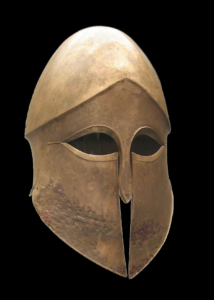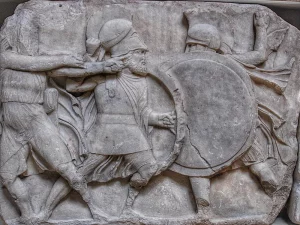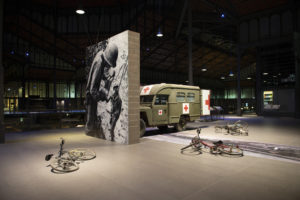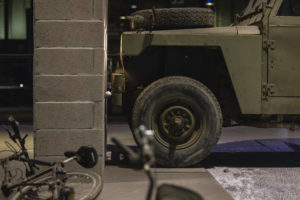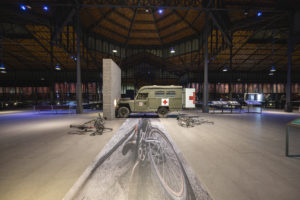
THE WELCOME EVIL
A work by Francesc Torres for El Born Culture and Memory Centre, Barcelona, 2023.
WHY WAR?
BECAUSE IT IS POSSIBLE,
EMINENTLY HUMAN,
EMOTIONALLY POWERFUL
AND – AT TIMES –
NECESSARY.
Conversation of Melos
I am going to start this text by talking about the Peloponnesian War, the most modern of the ancient wars. During that war, a fateful event occurred, known by the generic name of the Melian Dialogue, that has been recounted by Thucydides, studied by all military academies in the world and cited tens of thousands of times in the past 2,500 years. In this exchange between the Athenians and the representatives of the Cycladic island of Melos (or Milo, as in the famous sculpture) in the Aegean Sea, the former were demanding that the latter join the Attic League (Athenian Empire) against Sparta and its Peloponnesian allies. The Melians responded reasonably that they were neutral, that in the past they had helped both sides before they became enemies, that they had traded with both, that many Spartan and Athenian men had found a Melian wife and vice-versa, and that therefore they thought it was an unjustifiable atrocity to put an end to this state of affairs that was so beneficial to all parties. The Athenians responded that they didn’t care what had happened in the past, and that if Melos did not join Athens they would invade the island, kill all their men of military age and all the elderly and sell the women and children or keep them as slaves. The Melians, outraged, asked how they were able to threaten people who had never been dishonest or unreasonable with Athens with something so cruel and unfair. The Athenians responded: “Because we can”. This atrocity committed by Athens in 416 BC scandalised Euripides enough that it prompted him to write the anti-war play The Trojans so his compatriots could reflect indirectly on wars in toto and the misery they bring in their wake.
This episode might tempt us to consider it a universal explanation of the stubborn persistence of war in human affairs, which is exercised whenever justifiable reasons exist, either real or perceived, coupled with calculated guarantees of success (no one ever went to war thinking they would lose it). However, though pointedly and tersely clear, the Athenians’ response only scratched the surface of the problem of war, besides the fact that it is always a manifestation of politics by other means. Yet this does not explain everything either, nor does saying that the root of war is economic. As an art and a religion, war is one of the most complex, powerful and profoundly human expressions that exist.
What is the war?
In her book on the sacred origins of war, Barbara Ehrenreich suggests that, when it is won, war is the symbolic representation of the “moment” when we cease being prey to become the most implacable predator in the history of the universe, or more plainly put, when we cease being the lunch to become the eaters. There may be other theories, but all the explanations of war’s causes, with the manifest intention of finding the tools needed to eradicate it, fail – or come up short – due to its unfathomable magnitude; after all, in essence, we do not actually understand its most primal urge. It is always easier to determine what things are not than what they are. We know, for example, that war is not a behavioural fossil we have been carrying around, unable to shed, since we first climbed down from the trees. It has nothing to do with biology other than the fact that one cannot fight without aggressiveness, which is a genetic response. But a massive skirmish with deaths among gang members or fans of rival football teams is not war. A war is declared (although increasingly less so); that is, it is agreed upon. It is a dialectical process of blunt communication among combatants. It has rules, written laws, behavioural patterns, an ethos. It is accepted by the main religions. It has its own attire. It has a technological, economic and political base and a language of its own. It requires an initiation – it is something that a civilian cannot understand, just like the illiterate mediaeval Christian could not understand the priests’ Latin that so befuddled them. And it has a natural momentum towards becoming total (limited wars are either lost or fail to reach conclusive results).
A military career is a fully honourable profession taught at highly specialised universities like Saint Cyr in France, West Point in the United States, Sandhurst in the United Kingdom and the Frunze Academy in Moscow. The fact that the Spanish crown princess is attending the Military School of Zaragoza exemplifies this. It is also learned indirectly in primary and secondary school in all countries by studying those countries’ past wars, which virtually nobody repudiates. And finally, it is learned by playing. What we can glean from all of this is that if war is something discernible and unquestionable, it is first-order culture that is totally integrated into the social fabric as a determining force in the creation of states, as a driver of technological innovation and social change which entails and implies, according to Ian Morris, the paradoxical and perverse civilising capacity of the unstoppable statistical reduction in systemic violence, for example.
Reduction, not elimination. Surely the reader is reacting the same way I reacted when I read that author. Morris begins: War: What is It Good For by warning readers that they are going to hate everything he says in it, and especially hate Morris for saying it. He then spends the next 350 pages of the book very effectively demonstrating his thesis, which can be summarised as follows: while in the Pleistocene the percentage of deaths by violent conflict was around 20% – pure savagery, even if there were only a handful of us – currently, counting the last two World Wars and all the other wars with them, including the Holocaust, war causes fewer than 1% of deaths.
Even if not all of us are aware of this figure – assuming that it can be backed up – we could venture to claim that if it is so difficult to eradicate this eminently human thing we call war, it is because we are somehow not completely free of the suspicion that armed conflict – and we are not justifying it –is not as futile as it seems, and that ultimately this “usefulness” makes it even more morally tragic than we are able to accept. Morris says that states are invariably associated with war because they tend to be an outcome of it, and once they are consolidated, they tend to offer their citizens protection and safety, even, mind you, when those states are not democratic. Any state would rather its citizens be working, creating wealth and paying taxes instead of using this energy to kill each other, which is what is happening in failed states like Haiti, Syria and Libya. One current example that concerns us: if Ukraine loses its war against Russia, it will probably cease to exist as such, and if Russia loses, it may conceivably be the country that disintegrates. The consequences of both outcomes could be globally catastrophic. Morality and justice aside, both countries know what is at stake. Europe and the United States know, too.
Armed conflict: an atavistic ritual of the human being
I think that the perception and occasional acceptance of armed conflict by citizens of any country is conditioned by a series of clichés aimed at camouflaging truths about ourselves that are so unbearable to accept that they compel us to tell an intellectually dishonest and ethically questionable story that makes it possible to downplay the evidence of what human beings are capable of with disturbing ease and even enthusiasm, namely going from a situation of peace to war anytime the occasion arises, which happens with almost liturgical regularity. We need only watch the documentary footage from the beginning of the First World War, especially in France, as the troops were mobilising and heading to the front. Everything is happening in a festive, almost carnivalesque atmosphere, with the columns of soldiers parading with smiles on their faces, flanked by happy women bidding them farewell with cheers and white handkerchiefs, as if they were leaving to participate in a sporting event. Everyone was shouting that the war would be over by Christmas. We know now what happened after that (incidentally, according to none other than the Pentagon, the current war in Ukraine was literally supposed to last three days).
We all know that after the twentieth century, with its two World Wars, plus the civil wars in Spain, Greece, South Africa, Rwanda, Korea and Vietnam and the wars in the Middle East, the Balkans and the two Gulf Wars. (and the list goes on), we have begun the twenty-first century with more of the same in Iraq, Afghanistan, Syria, Libya and Ukraine and the possibility of a clash between the USA and China that is becoming less and less theoretical. Therefore, it is clear that the dissuasive potential of lived experience is zero, given that it does not prevent the repetition of a dreadful ritual that always surpasses the previous conflict in its disastrous magnitude. Just look at the statistics on the two World Wars last century to see that the 50 million-plus deaths in the second one, the greatest human catastrophe in history, did not manage to dissuade all the repetitions of the same tragedy that came afterwards, including the ethnic cleansing in the Balkans right in self-satisfied, civilised Europe, dovetailing with the commemoration of the fiftieth anniversary of the end of World War II. The experience of the Somme in the First World War, a battle that lasted almost five months, from 1 July to 18 November 1916, caused a million causalities and changed absolutely nothing, not on the battlefield, nor in the course of the war, nor in the mindset of the combatants from the same nationalities that fought each other twenty years later on the very same battlefields. On the first day of the Somme offensive alone, the English had 57,000 causalities, 19,000 fatal. And we should not forget that this was supposedly the war to end all wars, although the same was said of the Crimean War waged sixty years earlier.
While it is almost impossible for us in democratic societies to ignore war, with which we are always complicit, it pains us, beginning with when we pay the taxes needed to fund armed forces that are only used for one thing. So, we are faced with the quandary that no matter how terrible wars are, some of them have to be fought due to moral imperative. The Second World War is the perfect example. Without the Allied victory over German, Italian and Japanese totalitarianism, today we would live in a very different world that would unquestionably be worse in every regard. Only one thing could be done with fascism: destroy it. And I believe that readers would agree with me that had it been possible to do to Franco what was done to Hitler and Mussolini, Spain would not have been the tragically wretched country that it was throughout much of the twentieth century. In fact, sociologically speaking, Spain still is what it is as a direct consequence of the Franco regime, which still exists as an ideological option in today’s political spectrum. Democracy has not served as an antidote to keep it at bay, despite having lived and suffered through a civil war and forty years of dictatorship, which fewer and fewer Spaniards want to recall.
THE WELCOME EVIL
When I set out to do a project on war for the El Born Culture and Memory Centre, I thought it imperative to make it clear that simply saying that war is unacceptable savagery would not be worth either the effort or the public spending. We already know this, and unfortunately, glancing at the statistics, we know that it does us no good. We would have to go much further in an attempt to understand and outline why it exists as a biblical curse that is apparently impossible to eradicate from the record of human behaviour. Which doesn’t only happen because there are a few evil people with too much power who make it possible when they wish. Far from it. There are cruel Putins who earn political clout with the indiscriminate use of military force for the greater glory of the Motherland, and for their own glory for good measure, but the problem is more complex and goes beyond this. We are all responsible and deeply complicit in the outbreak of an armed conflict, because a war, just like a baptism, is impossible unless the humans show up, and there has not been a single war in the history of humanity that had to be suspended due to the mass desertion of the armies involved. Hence, the sarcastic title of this project.
Now I will talk about the elements comprising the installation and the fact that they are all ambiguous, with double meanings, their narrative articulation neither affirming nor denying, justifying nor condemning. There is no sanctimonious or earnest moral of the story. Everything is manifested with an unsparing specificity of form, such that if it does prompt a cathartic reaction in the classical Greek sense of the term, it will be outside it, outside the work, in the minds of the spectators, in that analogue space where all alternatives are possible. I hope I have accomplished this, although I cannot be sure.
The main element is a military vehicle. If it were an armoured car, its meaning would be unequivocal based on its purpose, size and weapons, but it is an ambulance, a vehicle meant to save lives, an oxymoron in open warfare. A tank could also serve a “morally” positive purpose if it is used to take down a tyrant like Hitler, but I wanted something much more ambivalent. So let us agree that an ambulance is as military as a combat vehicle. Here, the vehicle is parked against a wall, holding up a fresh egg – life – by pressure alone. If it pushes too hard it will crush it, but if it lets it drop the outcome is no better. The nature of power consists of its ability to implement one of the three possible options, with the understanding that natural common sense will accept the constant pressure of power as long as it neither crushes nor drops it, such that the weak, on their own initiative, ask to be “protected” by the real power of the state through its real monopoly on both violence and benevolence. This explains the acceptance of police force, for example, which is always preferable to the fear inspired by its absence, or even worse by a civilian population armed to the teeth.
On the other side of the wall that the ambulance is facing is an iconographic wall image from the Second World War, namely the famous photograph by Eugene Smith taken in Saipan in 1944, in which a US marine is holding a living, naked Japanese baby that he just found in a hole, under rubble, as a fellow soldier is looking on. In this monumental and ambiguous image, a soldier covered with the filth of weeks in abominable combat conditions, during which he may have killed an indeterminate number of Japanese soldiers in the Dantesque setting of the Pacific jungle, stops to pick up a weeks-old Japanese baby perhaps hidden by its mother before she killed herself by jumping from a nearby cliff into the sea. Eugene Smith was there and shot the picture. He shot it without killing anyone. The overwhelming power of this image lies in its bipolarity, its raw depiction of a human being able to harbour the ability to both kill others and save them. The same hands that are holding the baby were used to hold a rifle and bayonet, which may have mercilessly eviscerated an enemy half an hour earlier. It is an indescribable image that heralds hope. Despite everything, the blood coursing through our veins does not override mercy. A second, anamorphic, image covers the floor under the ambulance and can only be seen properly from a single vantage point. This image comes from the war in Ukraine and was taken in Bucha in 2022; it shows an unarmed civilian man whom the Russian soldiers killed while he was riding his bicycle. He fell on his side with his feet in the pedals, and that is how he remained. He needed no medical care. The dead civilian is the quintessential victim of any war; no other victim has the same moral charge. Other real bicycles, old and rickety, are scattered in the space around the vehicle and complete the installation.
The military ambulance has its two back doors open, so you can see inside it, where a plasma screen shows a video loop comprised of a montage of moving images from different wars and other military counterpoints, which are spliced in with a sequence of shots of a young mother nursing her baby. This sequence, which is the tragic epicentre of the piece, may alarm spectators who read it literally as a condemnation of motherhood as a producer of the canon fodder needed to feed both factories and battlefields, a perhaps paradigmatic image that is inextricably linked to the First World War yet has underlain every war since the beginning of time. Of course, that is not the intention. It is much more primal and deeper, given that there is no greater tragic contradiction than the one between the birth of a human being and the massive, unnatural death that has occurred in all wars throughout history, but especially in the wars of the past 200 years due to their ability to adapt death to the industrial and technological processes of modernity. People are killed on the same scale as cars and electronic chips are manufactured. It is systemic. Why? The same reason the Athenians gave the Melians twenty-five centuries ago: because we can. Power has power. And within this context of tangible possibility is where we have to ask all the questions and strive to find all the answers. The dark pit of war will be bottomless as long as power has power.
Hence, the premises of this work, which spans art, history and the miracle of not killing when we have the power to do so.
Francesc Torres, Jersey City, 2023.



